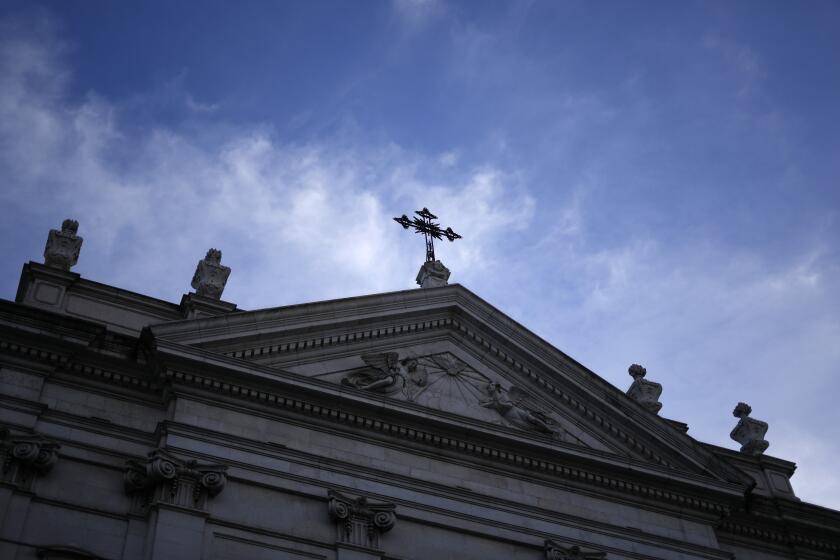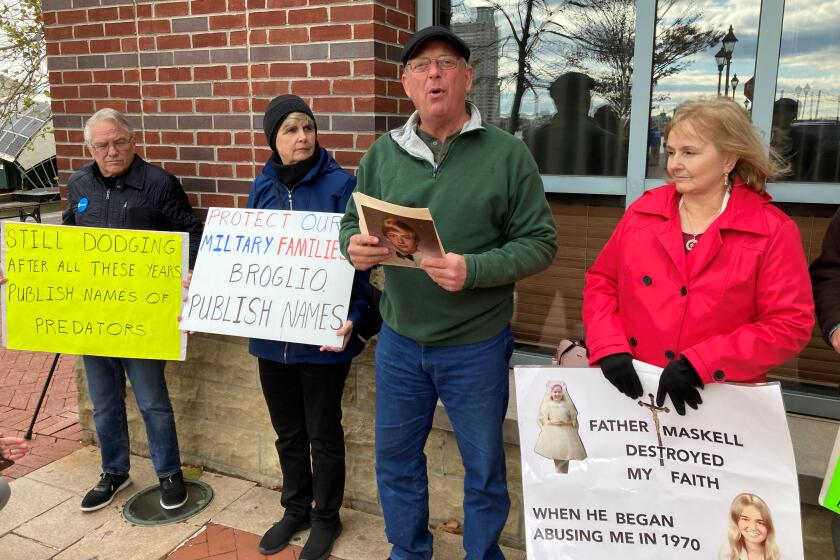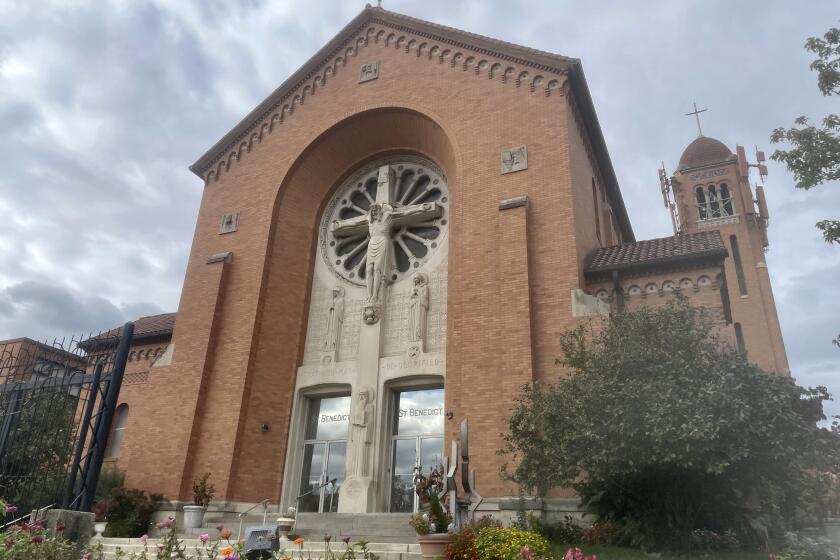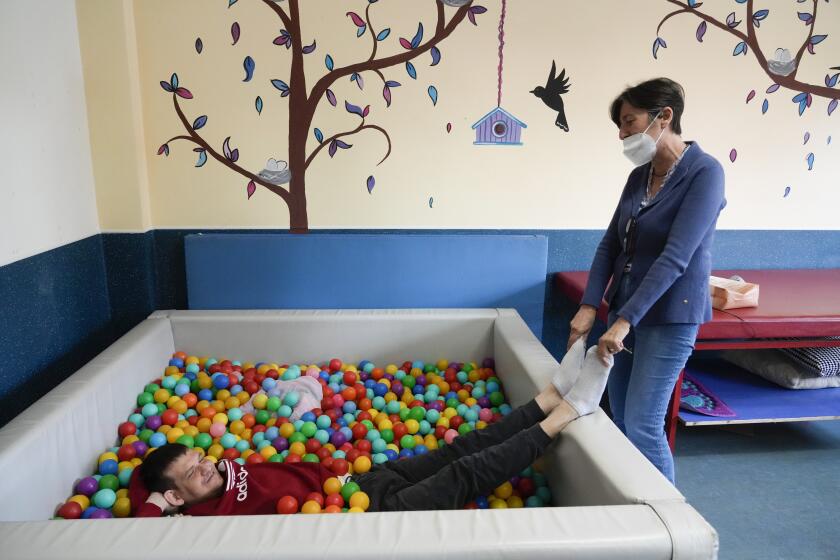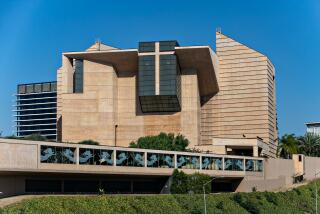In U.S., Black survivors of the Catholic clergy sexual abuse crisis are nearly invisible
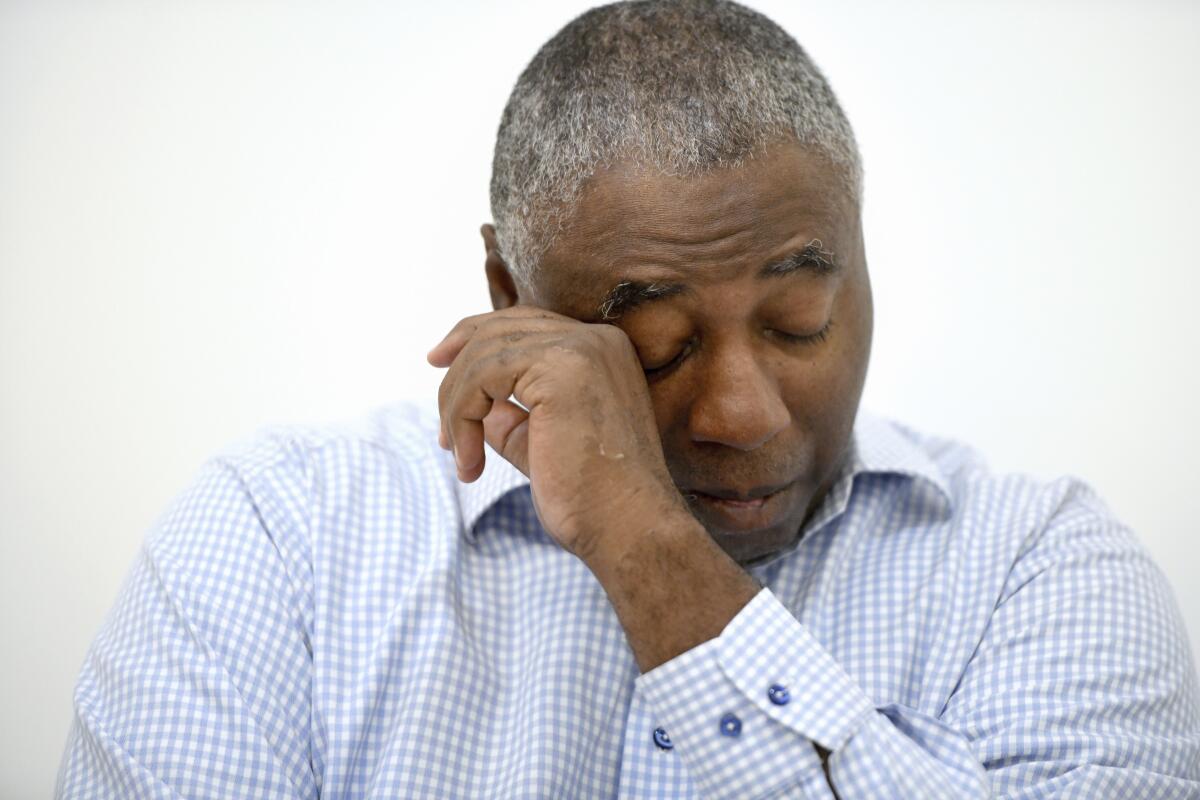
- Share via
BALTIMORE — As Charles Richardson gradually lost his eyesight to complications from diabetes, certain childhood memories haunted him even more.
The Catholic priest appeared vividly in his mind’s eye — the one who promised him a spot on a travel basketball team, took him out for burgers and helped him with homework. The one, Richardson alleges, who sexually assaulted him for more than a year.
“I’ve been seeing him a lot lately,” Richardson said.
As a Black middle schooler in Baltimore in the 1970s, Richardson started spending time with the Rev. Henry Zerhusen, a charismatic white cleric. Zerhusen’s parish was a fixture in a neighborhood experiencing white flight and rapidly becoming majority-Black. Zerhusen welcomed his church’s racial integration and implemented programs for struggling families, including Richardson’s.
Black survivors like Richardson have been nearly invisible in the Catholic Church sexual abuse crisis — even in Baltimore, home to a historic Black Catholic community in the nation’s oldest archdiocese. Cases of clergy abuse among African Americans are underreported, experts say, and the U.S. Catholic Church generally does not publicly track the race or ethnicity of victims. Without that data, the full scope of the abuse and its effects is unknown.
More than 150 Catholic priests and others associated with the Archdiocese of Baltimore sexually abused more than 600 children over the last 80 years.
“Persons of color have suffered a long legacy of neglect and marginalization in the Catholic Church,” said the Rev. Bryan Massingale, a Black Catholic priest and Fordham University professor whose research has focused on the issue. “We need to correct the idea that all or most of the victims of this abuse have been white and male.”
Earlier this year, the Maryland attorney general’s office released a scathing report on child sex abuse within the Baltimore archdiocese. The report documents more than 600 abuse cases but leaves out any context about race. There are clues, however, in the names of priests and churches listed.
Out of 27 parishes in the archdiocese that have significant Black populations, at least 19 — 70% — previously had priests on staff accused of sexual abuse, according to an Associated Press analysis. For parishes that experienced demographic shifts, these abusers were in residence in the years after Black membership increased and white membership declined.
In 2013, Zerhusen faced accusations from another former parishioner — the grandson of a woman who had worked at St. Ambrose. The archdiocese settled with the victim for $32,500 and added Zerhusen to their list of credibly accused priests.
Christian Kendzierski, an archdiocese spokesperson, said he was just learning of Richardson’s allegation about Zerhusen, who died in 2003, when contacted by the AP.
An investigation by Maryland’s attorney general has identified 158 Roman Catholic priests in the Archdiocese of Baltimore accused of sexually and physically abusing more than 600 victims over the last 80 years.
The last time Zerhusen abused him, Richardson said, he jumped out a stained-glass window to escape. He still bears scars that he attributes to the fall.
But the emotional scars have never healed. Until recently, he had never told his family about the assaults.
As Black men, “we have a reputation we have to carry with us, a façade,” Richardson said. “Something like this is one of the worst things — to say you have been raped or touched by another man.”
After the attorney general’s report, Maryland lawmakers voted to repeal the statute of limitations for child victims to sue. At age 58, Richardson retained a lawyer and decided to go public.
Ray Kelly, chair of the pastoral council at St. Peter Claver, a Black Baltimore parish, said the archdiocese has failed to address racial disparities.
“The Americanized Catholic Church still sees the Black population as a perpetual charity case, so to speak,” he said. “And the predators are going to go where the prey is — Black communities relying on the church for support.”
The Catholic Archdiocese of Baltimore will close one of its churches after its longtime pastor was recently suspended from the ministry.
Abuse also came from within Baltimore’s Black community.
When he was ordained in 1974, Maurice Blackwell was a celebrated rarity: a homegrown Black priest. Since then, he has been accused of sexually abusing at least 10 boys under 18, most at majority-Black parishes.
Darrell Carter alleges he was one of Blackwell’s victims. Now 63, he decided to sue under the new state law.
As a teen, Carter visited two of Blackwell’s parishes looking for odd jobs. Instead, he said, Blackwell sexually abused him for four years and paid him $25 each time. Carter said Blackwell brandished a gun and threatened to kill him if he told anyone.
Carter said he reported the abuse to the archdiocese several years later, but nothing came of it. The archdiocese said it received a report of Carter’s abuse in 2019 and reported it to law enforcement. Blackwell didn’t respond to recent messages seeking comment.
Of the abuse, Carter said, “There’s not a day that goes by that I don’t think about it.”
Scandal: Cardinal also releases a list of clerics accused of molestation. Some of the allegations dated to the 1950s.
In 2002, another of Blackwell’s victims, Dontee Stokes, confronted and shot Blackwell after he refused to apologize. The shooting became a defining event in Baltimore’s mishandling of clergy sex abuse claims, just as the scope of the crisis was breaking open in Boston.
Blackwell survived, and Stokes was later acquitted of attempted murder. He served 18 months of home detention for gun charges.
Stokes had reported the abuse nearly a decade before the shooting, but police never filed charges. Although the archdiocese found his claims credible, its leaders returned Blackwell to the ministry. Blackwell was finally removed in 1998 after another victim came forward.
But it was only after the 2002 shooting that Blackwell was formally expelled from the priesthood and criminally charged. Despite being convicted of three counts of child sexual abuse, he was granted a new trial because of the “improper testimony about possible other victims,” according to the attorney general’s report. Prosecutors ultimately declined to retry him.
In 1990, not long before Blackwell was first publicly accused, Gloria Webster’s daughter became suicidal and admitted she had been sexually abused by her youth pastor, the Rev. Richard Deakin, starting when she was 13.
“It was like I was suing God,” said Webster, who pursued criminal and civil charges against Deakin. “All my friends turned against me.”
An internationally lauded federation that provides community care for people with intellectual disabilities is grappling with revelations that its late founder perverted Catholic doctrine to justify his sexual abuse of women.
Meanwhile, Angelique Webster navigated the case between psychiatric hospitalizations. “I couldn’t hide from it because it was there all the time,” she said.
Deakin pleaded guilty to second-degree rape and child sex abuse, receiving no jail time with a suspended sentence and probation. He later became a social worker at a Department of Veterans Affairs facility in Pennsylvania. He didn’t respond to a message seeking comment.
In 1993, the Websters settled out of court for $2.7 million, a staggering sum for the archdiocese, where most settlements fall under $100,000.
Survivors coming forward now will likely receive smaller settlements since the archdiocese declared bankruptcy.
But for his part, Richardson recently found solace in telling his daughter about the abuse: “A great weight has been lifted off my shoulders.”
He’s retired now, but Richardson recalled a moment that stood out during his career as a car salesman — when another clergy abuse victim walked into his dealership. That was sometime after Stokes had shot Blackwell, and Richardson recognized him from media coverage. Before selling him a car, Richardson told Stokes he was proud of him.
But he couldn’t yet say what he really wanted to share: that it happened to him too. Now, he finally can.
More to Read
Sign up for Essential California
The most important California stories and recommendations in your inbox every morning.
You may occasionally receive promotional content from the Los Angeles Times.
